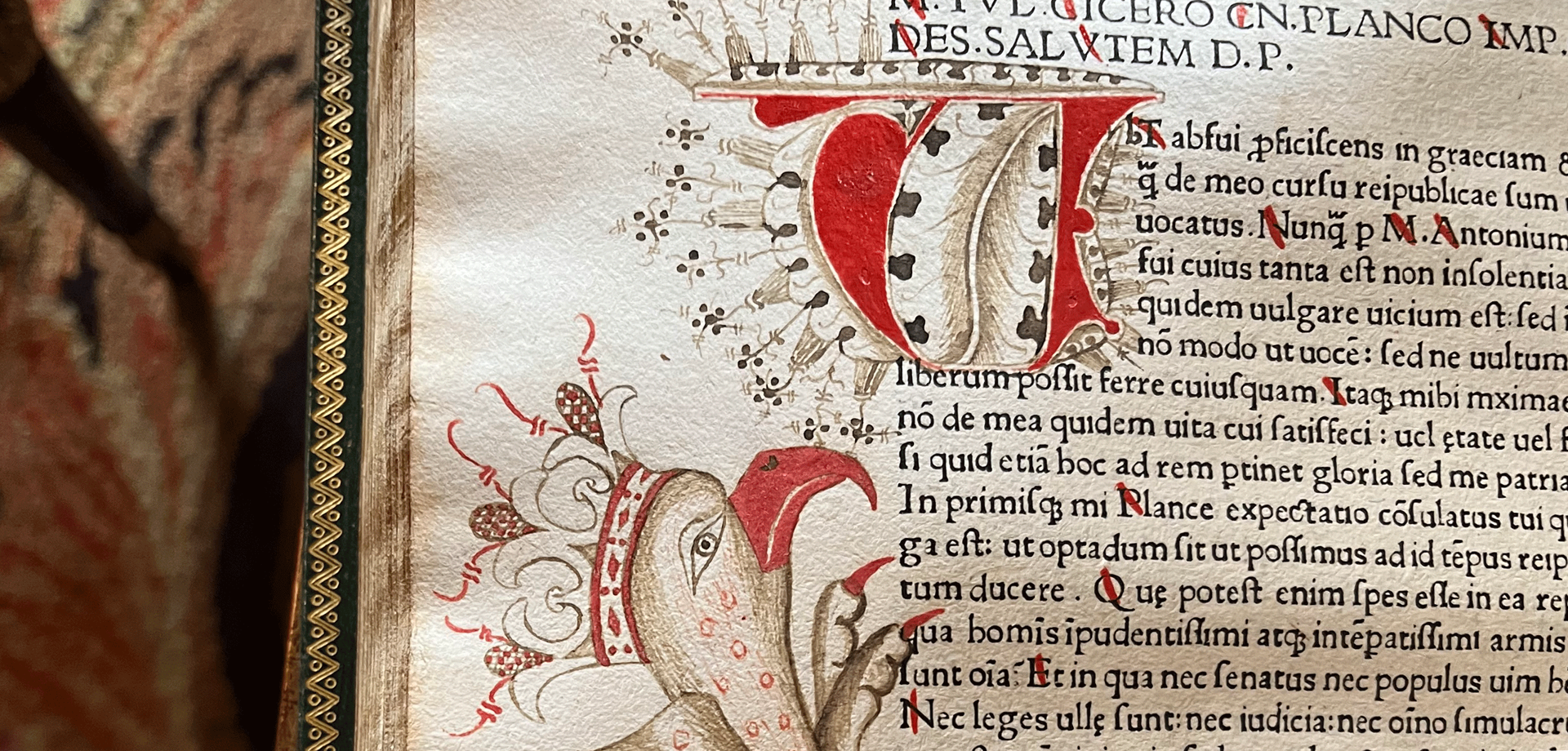Charlotte Newcombe is a PhD researcher at the University of York, who has recently been working with our Archive and Library team.
Chatsworth's 630 incunables
Since January, I’ve been working on a project in Chatsworth’s Library with its extensive collection of incunables. “Incunable” derives from the Latin incunabula meaning swaddling-clothes and is used for books printed before 1501, when European printing was in its infancy. At the beginning of the project we thought that Chatsworth had around 545 incunables, but it now seems likely that the true number is closer to around 630.
The project has allowed me to see some of Chatsworth’s many fascinating books. Probably the oldest printed book at Chatsworth is an edition of Thomas Aquinas’ De articulis fidei et ecclesiae sacramentis printed in Mainz in about 1459 and recently attributed to the printer Johannes Gutenberg, the inventor of the movable-type printing press. Only around seven copies of this book are known to survive. A digitisation of Chatsworth’s copy of this book is available on the Princeton University website.
Italian printed incunables
While Germany is renowned as the birthplace of European printing, the vast majority of the Chatsworth’s incunables were printed in Italy. Among these, are two of the earliest printed books in Italy. Arnold Pannartz and Conrad Sweynheym were the first two printers in Italy, and before they settled in Rome in 1467 they printed four books at a Benedictine Abbey in Subiaco. The first of these doesn’t survive, but Chatsworth has two of the remaining three in its collection: an edition of Lactantius’ Opera printed in October 1465 and an edition of Augustine’s De civitate dei printed in 1467.
By far the most common author in Chatsworth’s incunables collection is Cicero. The most spectacular of Chatsworth’s many Ciceros is a 1472 edition of Epistolae ad familiares that contains some stunning illustrations of real and mythical animals.
Images from Circero, Marcus Tullius. Epistolae ad familiares. [Milan]: Philippus de Lavagnia, 25 Mar. 1472.
Ovid's Metamorphoses
Some of Chatsworth’s incunables also have heavily illuminated first pages, while others contain extensive notes from their early readers. Both images below show the beginning of Ovid’s Metamorphoses in two different editions of his works. The first is heavily decorated, including an image of Ovid himself in a wreath in the outer margin. The second is less beautiful, but contains detailed annotations on the beginning of the poem. For example, notes on Ovid’s description of the chaos before the world’s creation are visible in the top right corner.
On the left: Ovidius Naso, Publius. Opera. Ed: Johannes Calphurnius. [Venice]: Jacobus Rubeus, [before Dec.] 1474.
On the right: Ovidius Naso, Publius. Opera. Ed: Barnabas Celsanus and Bonus Accursius. Venice: Bernardinus Rizus, Novariensis, 1486-87.
Latin poetry
Chatsworth has two fascinating copies of Marcus Manilius’ Astronomica, a Latin poem about astrology. The first is a 1474 edition that contains extensive handwritten notes, seemingly by fifteenth century astrologist and writer Lorenzo Bonincontri (or Laurentius Bonincontrius). Bonincontri produced a commentary of the Astronomica that was printed in Rome in 1484. The library also has a copy of this later edition, containing the signature of Henry Spelman, a renowned sixteenth and seventeenth century English antiquarian. Some of the printed diagrams in the 1484 edition are remarkably similar to those drawn into the earlier edition, apparently in Bonincontri’s hand. Chatsworth’s copy of the 1474 edition therefore seems to feature Bonincontri’s notes that later became the printed commentary in the 1484 edition.
On the left: Manilius, Marcus, Astronomicon. Add: Aratus: Phaenomena (Tr: Germanicus Caesar), (Bologna: Ugo Rugerius and Doninus Bertochus, ’20 Mar.’ 1474). The image contains handwritten notes, purportedly by the scholar Lorenzo Bonincontri.
On the right: Manilius, Marcus, Astronomicon. Comm: Laurentius Bonincontrius, (Rome: [Printer of Manilius, ‘Astronomicon’], 26 Oct. 1484).The image contains a woodcut very similar to the hand drawn diagram on the left.
Finally, some of Chatsworth’s incunables contain clues that suggest how they might have once been stored or used. The 1475 edition of Diogenes Laertius’ Vitae et sententiae pictured below has the author’s name and the title written on the foreedge, indicating that the book once would have been stored with its pages facing outward. In the book pictured on the right, small static bookmarks have been glued onto to some of its pages, perhaps suggesting the beginning of new sections of the text or moments that were particularly interesting to its reader.
On the left: Diogenes Laertius, Vitae et sententiae phiosophorum. Tr: Ambrosius Traversarius. Ed: Benedictus Brognolus (Venice: Nicolaus Jenson, 14 Aug. 1475).
On the right: Valerius Maximus, Gaius, Facta et dicta memorabilia (Mainz: Peter Schoeffer, 14 June 1471).
In this blog, I’ve only scratched the surface of Chatsworth’s significant collection of incunables. Plenty more fascinating discoveries await uncovering.
Chatsworth holds an extensive archive that includes the personal papers of the Devonshire family, historically significant acquisitions, and estate and staff records. The charity funds the preservation, restoration and cataloguing of these papers, sharing the findings to advance our understanding of historical figures, events and places, and to make them available to anyone conducting research for academic or personal reasons. Find out more about our archives and library.





